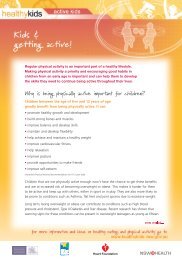I Move We Move - Good For Kids - NSW Government
I Move We Move - Good For Kids - NSW Government
I Move We Move - Good For Kids - NSW Government
You also want an ePaper? Increase the reach of your titles
YUMPU automatically turns print PDFs into web optimized ePapers that Google loves.
v<br />
Glossary of symbols and terms<br />
In I <strong>Move</strong> <strong>We</strong> <strong>Move</strong> there are symbols that refer you to:<br />
Another section of<br />
The Guide or The<br />
Physical Activity<br />
Handbooks<br />
In I <strong>Move</strong> <strong>We</strong> <strong>Move</strong> the following terms are frequently used:<br />
Physical activity is defined as any bodily movement produced by skeletal muscles which results<br />
in energy being expended. Physical activity can occur during games, play, sports, and travel<br />
between places1 .<br />
Fundamental movement skills are specific gross motor movements that involve different body<br />
parts such as feet, legs, trunk, hands, arms and head. They are the ‘building blocks’ or foundation<br />
movements for more complex and specialised skills required to play different games, sports and<br />
recreational activities offered during the school years and in the community 2 .<br />
Physically active play (otherwise referred to as free active play) is periods of time when<br />
children are free to choose their own activities and where the activities require a child to be<br />
physically active.<br />
Planned, adult guided developmental movement activities are where adults extend children’s<br />
learning opportunities with regards to developmental movement for babies. Through intentional<br />
teaching and guidance to assist them to discover their potentials and achieve their learning goals3 .<br />
Planned, adult guided fundamental movement skills learning experiences are where adults<br />
extend children’s learning opportunities with regards to fundamental movement skills for toddlers<br />
and preschoolers through intentional teaching, and guidence to assist them to discover their<br />
potentials and achieve their learning goals 3 .<br />
Sedentary behaviour is when a child is inactive, either lying or sitting down. In the early education<br />
and care setting this includes times that children are seated but not meal time or nap time, e.g. if a<br />
teacher puts table toys on a table and children are only allowed to sit at the table and play, circle or<br />
group time on floor, TV viewing, etc.<br />
Small screen recreation is a specific type of sedentary behaviour where a child is using the computer<br />
or television (broadcast, videos, DVDs or electronic games) for recreational, not educational purposes4. I <strong>Move</strong> <strong>We</strong> <strong>Move</strong>, The Guide Edition 1 August 2009<br />
A specific resource<br />
within The Guide or<br />
any of The Physical<br />
Activity Handbooks<br />
A resource on<br />
the accompanying<br />
CD-Rom or DVD<br />
AREA HEALTH SERVICE




